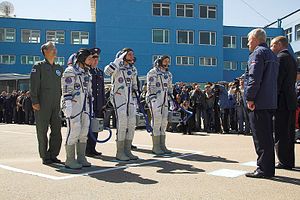South Korea has successfully sent a new science satellite into space, moving one step closer to its goal of becoming a major space power.
The Korea Multipurpose Satellite-3A (Arirang-3A) was launched on March 26 from the Yasny launch base in Russia. The satellite, which cost the Korea Aerospace Research Institute (KARI) about 230 billion won ($208 million) for development, will go through an early operating stage for up to six months. After that stage is complete, South Korea will become able to monitor the peninsula for 24 hours regardless of the weather by running three satellites: Arirang-3A, 3, and 2.
Arirang-3A is equipped with a mid-infrared sensor, which will allow it to detect events emitting high-temperatures (such as a forest fire, volcanic activity and even the operation of a nuclear facility). In addition, the optical cameras for the satellite have been greatly improved, so KARI is expecting to gather a variety of information with Arirang-3A.
Many see the successful launch of Arirang-3A as a big step for South Korea’s space technology, since it was the first satellite developed by private companies with skills learned from KARI. The previous satellites were developed by KARI, which is a government-funded organization.
Prior to the launch, the South Korean government announced on February 12 that it will devote itself to space development in order to become one of major space powers. It set goals of developing a Korean-made launch vehicle and space payload as well as improving South Korea’s ability to utilize information gathered by satellite. The project to develop a homemade launch-vehicle will enter its second stage in August. The South Korean government decided to invest about 2 trillion won ($1.8 billion) between 2010 and 2021 on its space programs. In addition, the government promised that it will devote more efforts to nurturing space experts and increase financial support to companies related to the space sector.
Lee Seok-jun, vice minister for South Korea’s Ministry of Science, ICT and Future Planning, said the relevant government organizations will continue to cooperate to successfully push forward the government’s plan to become a space power.
This was not the first time South Korea announced its ambition of becoming a space power. South Korea launched the so-called “Astronaut Project” in 2004, which aimed at nurturing the country’s first-ever astronaut. As a result, Yi So-yeon was sent to the International Space Station (ISS) on board a Russian rocket in 2008.
Yi’s visit to the ISS raised hopes among South Korean people that the country was one step closer to its goal of becoming a space power. South Korea’s government also was eager to promote Yi as the “first astronaut of Korea” in order to garner public support for developing Korea’s space program.
After her return from ISS, Yi spent the majority of her time on public relations. Some critics began to question the value of Yi’s contributions to South Korea’s space ambitions. The question was also a critique of the government, as an astronomical sum was spent on the astronaut project.
Eventually, Yi quit KARI, where she had been working as researcher. Yi confessed that she felt she was being personally blamed for the failures of the space program, even though the government’s policy was problematic.
The South Korean government faced condemnation after Yi quit KARI, with critics saying that Seoul had been fairly passive about investing in Korea’s space program in the wake of Yi’s 2008 journey. Yi’s case is a classic example of what South Koreans call “the head of a dragon and the tail of a snake” (meaning “a bright beginning and a dull finish”). Here’s hoping that this time, South Korea’s space ambitions won’t be revealed as the “tail of a snake.”
































